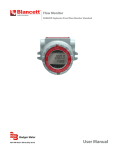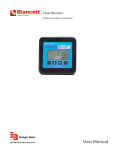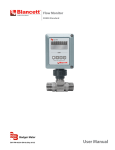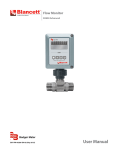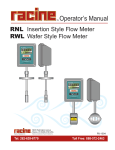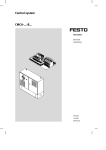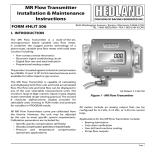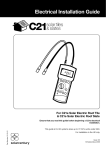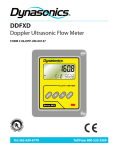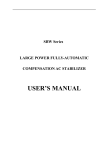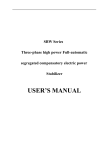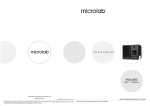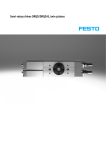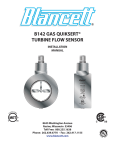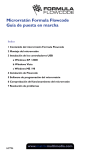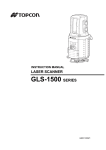Download Blancett B2800 Explosion Proof Manual (Simplified) PDF
Transcript
B2800XP Flow Monitor Simplified Explosion-Proof Version - For Liquid Meters - PROGRAMMING & INSTALLATION MANUAL 8635 Washington Avenue Racine, Wisconsin 53406 Toll Free: 800.235.1638 Phone: 262.639.6770 • Fax: 262.417.1155 www.blancett.com TABLE OF CONTENTS Introduction ................................................................................................3 Specifications..............................................................................................4 Installation ...................................................................................................5 Operating the Monitor ...........................................................................8 Programming Mode ................................................................................8 Programming ......................................................................................8 K-factor ...................................................................................................9 Totalizer...............................................................................................11 Password .............................................................................................11 Additional Input Options ...................................................................12 Battery Replacement ...........................................................................12 Maintenance.............................................................................................14 Additional Scaling Parameters........................................................15 Programming Menu .............................................................................17 4-20 mA Output Programming Menu ..........................................18 Troubleshooting .....................................................................................19 Dimensions ...............................................................................................20 Part Number Information ..................................................................21 Replacement Parts ................................................................................21 Statement of Warranty ........................................................................22 NOTE: Blancett reserves the right to make any changes or improvements to the product described in this manual at any time without notice. 2 Form No. B280-012 10/10 INTRODUCTION The B2800 Flow Monitor is a state-of-the-art, digital signal processing flow monitor designed to provide the user with exceptional flexibility at a very affordable price. Though designed for use with Blancett flow meters, this display can be used with almost any flow meter producing a low amplitude AC output or contact closure signal(s). The B2800 Flow Monitor is capable of accepting a low-level frequency input for calculating flow rate and total. These calculations can then be displayed in the desired units of measurement. All B2800 Flow Monitors come pre-calibrated from the factory, if ordered with a Blancett flow meter. If required, however, it can easily be re-configured in the field. The monitor’s large 8 digit by .50” numeric liquid crystal display makes extended range viewing practical. The second 8 digit by .25” alphanumeric display provides for selectable units viewing in run mode and prompts for variables in program mode. Finally, the user can choose between displaying rate, total or alternating between both rate and total. MENU ENTER Programming Buttons FIGURE 1 B2800XP Flow Monitor Form No. B280-012 10/10 3 SPECIFICATIONS Power Supply Options: Battery Powered: 1 “D” size, 1.5 Volt alkaline battery Loop Powered: 4-20 mA loop power Power Consumption: Battery Powered: Less than 1 mA @ 1.5 Vdc Loop Powered: 25 mA (maximum) Alphanumeric Rate and Total Display: 8 digit, .5” high numeric display 8 character, .25” high alphanumeric display Pulsed Output Signal: Outputs one pulse for each increment of the least significant totalizer digit Max Voltage: 30 Vdc Pulse Type: Opto-Isolated open collector transistor Pulse Width ON State: 20 mS / max pulse rate 20 Hz Current (ON State): 0.9 V drop @ 5.0 mA or 0.7 V drop @ 0.1 A Magnetic Pick-up Inputs: Frequency Range: 0 to 3500 Hz Trigger Sensitivity: 30 mV p-p Over Voltage Protected: ±30 Vdc Frequency Measurement Accuracy: ±0.1% Temperature Drift: 50 ppm / °C (max) Optional Analog Output (Loop Powered Version): 4-20 mA Current Loop Resolution: 1:4000 Transient Over Voltages: Category 3, in accordance with IEC664 Pollution Degree: 2, in accordance with IEC664 Mounting Classification: NEMA/UL/CSA Type 4 (IP66) Environmental: Operating Temperature: -22 °F to +158 °F (-30 °C to +70 °C) Humidity: 0-90% Non-condensing Certifications: CSA Ordinary Locations: To- C22.2 No. 1010-1 for Canada ISA S82.02 for US CSA Hazardous Locations: For- Class I, Div 1 Groups B,C, D Class II, Div 1 Groups E, F, G Class III; Type 4X; T6 @ 70 °F To- C22.2 No. 30 for Canada FM3615 for US 4 Form No. B280-012 10/10 EXPLOSION-PROOF ENCLOSURE The EIH Instrument Enclosure is designed to house instrumentation and control equipment as well as act as a conduit outlet body in hazardous, abusive and wet locations. The EIH enclosure is approved by Underwriters Laboratories Inc., Canadian Standards Association, Factory Mutual and CENELEC for use in Class I, Groups B*, C**, and D; Class II, Groups E, F, and G; and Class II hazardous (classified) locations as defined by the National Electrical Code® and Canadian Electrical Code. It is also NEMA/UL/CSA Type 4 and IP66 rated for watertight applications. * With conduit seals installed within 18 inches of enclosure. ** Unsealed conduit lengths must not exceed 5 ft. (152 cm). INSTALLATION WARNING: Electrical power must be “OFF” before and during installation and maintenance. 1. EIH Instrument Enclosures are furnished with ¾” NPT offset throughfeed cast hubs for conduit entries. (Use Cooper Crouse-Hinds RE21-SA to reduce to ½” hubs.) 2. Secure the enclosure to the conduit system. If the enclosure has mounting feet, select a mounting location that will provide sufficient strength and rigidity to support the enclosure as well as the enclosed device and wiring. CAUTION: Select a mounting location so that the enclosure will not be subjected to impact by heavy objects. Impacts can damage enclosed devices or glass lens. Form No. B280-012 10/10 5 3. Install Cooper Crouse-Hinds EYS Sealing Fittings required by Section 501-5 and/or 502-5 of the National Electrical Code® and Section 18 of the Canadian Electrical Code or any other applicable local codes and when enclosure is installed in Class I Group B hazardous locations. (For CSA Group C applications, unsealed conduit lengths must not exceed 5 ft. or 152 cm.) WARNING: The hazardous location information specifying class and group listing of each instrument enclosure is marked on the nameplate of each enclosure. CAUTION: All unused conduit openings must be plugged. Plug unused conduit openings with Cooper Crouse-Hinds PLG2. Plugs must be a minimum of 1⁄8” thick and engage a minimum of 5 full threads. 4. Unthread instrument (and power side) covers and carefully set aside to prevent damage to the cover threads and glass lens (when glass lens cover is used). 5. Pull wires into enclosure making certain they are long enough to make the required connections and to remove the instrument or power supply if servicing is required. Install instrument and power supply, if applicable, and make all electrical connections. NOTE: When installing device, be sure to check instrument dimensions to avoid interference with clamping ring on glass lens and the cover on standard units. 6. Test wiring for correctness by checking continuity and also check for unwanted grounds with insulator resistance tester. Make sure test equipment being used will not damage instrument to be housed in the EIH instrument enclosure. 7. Carefully rethread cover to enclosure housing. Tighten cover until cover flange contacts body face. 6 Form No. B280-012 10/10 CAUTION: Use care to prevent dirt, grit or other foreign material from lodging on threads. If such material settles on threads, clean with kerosene or Stoddard solvent*, then relubricate with Cooper Crouse-Hinds Type STL thread lubricant. * To avoid the possibility of an explosion, oxidation and corrosion, do not use gasoline or similar solvent. 8. Tighten cover set screws to prevent cover from loosening under vibration. WARNING: To maintain the explosion-proof integrity of the enclosure with a screw in a tapped mounting pad hole, there must be a minimum of 1⁄16” of material between the drill point and the back wall. If for any reason a screw will not be threaded into the drilled hole, a minimum of 1⁄8” of material must remain between the drill point and the back wall. Form No. B280-012 10/10 7 OPERATING THE MONITOR The monitor has two modes of operation referred to as the RUN mode and the PROGRAM mode. Both the RUN mode and the PROGRAM mode display screen enunciators confirm the state of the monitor. A quick glance at the lower left-hand corner of the LCD screen will confirm operating status. Normal operation will be in the RUN mode. To access the PROGRAM mode, press the MENU button until the first programming screen is displayed. After programming the display with the necessary information, a lock out feature can be turned on to prevent unauthorized access or changing the meter’s setup parameters. BASIC PROGRAMMING MODE Keys: MENU – Switches to PROGRAM mode UP Arrow – Scrolls through the parameter choices in forward direction and increments numeric variables RIGHT Arrow – Scrolls through the parameter choices in reverse direction and moves the active digit to the right ENTER – Used to save programming information, advance to the next programming parameter and in the reset process Modes: RUN – Normal operating mode PROGRAM – Used to program variables into the display If your monitor was ordered with a Blancett flow meter, the two components ship from the factory calibrated as a set. If the monitor is a replacement, the turbine’s K-factor has changed or the monitor is being used with some other pulse generating device, programming will be necessary. PROGRAMMING USING PULSE OUTPUT TURBINE FLOW METERS Each turbine flow meter is shipped with either a K-factor value or frequency data. If frequency data is provided, the data must be converted to a K-factor before programming the monitor. K-factor information, when supplied, can usually be found on the neck of the flow meter or stamped on the flow meter body. The K-factor represents the number of pulses per unit of volume. The K-factor will be needed to program the monitor readout. 8 Form No. B280-012 10/10 ENTER PROGRAM MODE – Change to PROGRAM mode by pressing the MENU button once. The mode indicator will change from RUN to PROGRAM. NOTE: If any input value exceeds the meter’s capabilities for that particular parameter, the LIMIT indicator will begin to flash indicating an invalid entry. Press ENTER once to return to the parameter’s entry screen to re-enter the value. MENU ENTER FIGURE 2 Front Panel SELECT METER SIZE – At the METER prompt, press the UP or RIGHT arrow keys to select the bore size of your meter. Press ENTER button once to save meter size choice and advance to the K-factor units selection. NOTE: The meter connection size and the bore size are different. For example, many of the 1“ NPT turbines have bore sizes that range from 3⁄8“ up to 1“. Be sure to use the correct bore size or the meter could report incorrect flows and totals. ENTER METER’S K-FACTOR UNIT – Directly after the METER size is selected, the display's K-factor unit must be chosen. Use the UP arrow key to select the K-factor unit. For meters calibrated in gallons, use PUL/ GAL (pulses per gallon); for meters calibrated in cubic meters, use PUL/ M3 (pulses per cubic meter); etc. Press ENTER to save the K-factor unit and advance to the next parameter. Form No. B280-012 10/10 9 NOTE: Unless otherwise specified, turbine flow meters are supplied with K-factors measured in pulses per gallon (PUL/GAL) which will automatically convert to your desired units of measure. NOTE: The K-factor supplied with the meter or calculated from calibration data will be needed to complete the next step. ENTER METER’S K-FACTOR – To change the K-FACTOR value, use the RIGHT arrow key and select the position of the number to be changed. Using the UP arrow key, increment the display digit until it matches the meter's K-factor digit. Repeat this process until all K-factor digits have been entered. Press ENTER once to save the K-factor and advance to the RATE/TOTAL unit selection. SELECT RATE/TOTAL UNITS OF MEASURE – The monitor allows the choice of five common rate/total units. The monitor indicates the rate/total unit of measure the display is currently set for. If the current selection is correct, press the ENTER key once to advance to the next parameter. To change to an alternate unit, use the arrow keys to scroll to the desired rate unit and press ENTER to save the choice. SELECTION GPM / GAL LPM / LIT M3PH / M3 M3PD / M3 BPD / BBL RATE Gallons per Minute Liters per Minute Cubic Meters per Hour Cubic Meters per Day Oil Barrels per Day TOTAL Gallons Liters Cubic Meters Cubic Meters Oil Barrels NOTE: The total unit's output multiplier cannot be modified in the Simplified program level. SELECT DISPLAY FUNCTION – The monitor can display RATE or TOTAL or alternate between BOTH rate and total. If the current selection is correct, press the ENTER key to advance to the next parameter. To change to an alternate display mode, use the arrow keys to scroll to the desired display mode and press ENTER to save the choice. 10 Form No. B280-012 10/10 A TEST function is also available in the Display Function sub-menu. With the test function selected, the display acts like a frequency counter and displays the raw input frequency being supplied to the frequency input terminals. This is very useful when troubleshooting flow problems. TOTALIZER PULSE OUTPUT – The pulse output parameter can be either enabled or disabled. When enabled this output generates 20mS duration pulse every time the least significant digit of the totalizer increments (20Hz max). The amplitude of the pulse is dependent on the voltage level of the supply connected to the pulse output and is limited to a maximum 30 Vdc. PASSWORD – Password protection prevents unauthorized users from changing programming information. Initially, the password is set to all zeros. To change the password, simply enter any 4 digit code using the arrow keys as previously described to enter the password value. Pressing ENTER once will store the password and take you back to the RST PSWD screen. NOTE: This password will allow users to reset totals. RST PSWD – Reset password protection prevents unauthorized users from manually resetting the flow monitor’s accumulated totals. Initially, the password is set to all zeros. To change the reset password, simply enter any 4 digit code using the arrow keys as previously described to enter the password value. Pressing ENTER once will store the reset password. NOTE: Entering a password in the PASSWORD screen and leaving the password blank in the RST PSWD screen would allow for total resets (not requiring password) and restrict programming modification. RESET TOTAL – To reset the monitor’s total display, in RUN mode press the MENU and ENTER simultaneously until TOTAL RST starts to flash. The TOTAL RST will stop flashing and the display will return to RUN mode at the conclusion of the procedure. STORE TOTAL – The current total can be manually stored in the monitor’s flash memory. This procedure may be desirable prior to changing the settings or replacing the battery. Press and hold the ENTER key for 2 seconds. The display will respond with a flashing TOTALSVD and then return to RUN mode. Form No. B280-012 10/10 11 AUTOMATIC STORE TOTAL – The monitor is equipped with a store total feature that works automatically, saving the current total to flash memory. The frequency of saves depends on the power supply option chosen. Battery Powered: Loop Powered: Once per hour and just before a low battery condition turns the unit off. Once every ten minutes. ADDITIONAL INPUT OPTIONS The B2800 Flow Monitor is capable of receiving magnetic pick-up input or a contact closure input. Since most Blancett flow meters utilize a magnetic pick-up, the monitor is shipped configured for magnetic pick-up input. To change to a contact closure input, remove JP2 from the bottom two pins and jumper them to the top two pins. See Figure 3 on page 13. BATTERY REPLACEMENT Battery powered monitors use a single 1.5V, “D” size alkaline battery. When replacement is necessary, use a clean fresh battery to ensure continued trouble-free operation. It is recommended that the total be saved to memory before the battery is removed. (See Store Total on page 11.) WARNING: Do not open explosion-proof enclosure unless the area is known to be free of hazards. Failure to make the area safe before opening the enclosure can result in a hazardous situation with a potential for injury. Carefully unscrew the enclosure cover to access the circuit board. Remove the four screws securing the circuit board to the enclosure. Lay the circuit board to the side being careful not to pull any wires from their connections. Clip the battery retaining wire/strap and remove the battery. Replace the battery being sure to observe the proper polarity and install a new retaining strap or wire. Reassemble the monitor reversing the disassembly process. 12 Form No. B280-012 10/10 +1 - 5 VDC +10 - 30 VDC 20 mS Pulse (Loop Supply Voltage - 5) 0.02 Loop Powered RMAX = 250 Typ 10K - + +30 VDC (Max) 4-20 mA Freq. In - + - + Pulse Out Pulse Inuput Mag Input Pulse Out Battery Powered 10K Circuit Board Layout FIGURE 3 20 mS Pulse +30 VDC (Max) External Totalizer Reset - + TB2 Reset External Totalizer Reset N/C N/C 4-20 mA Freq. In - + - + TB2 Reset Form No. B280-012 10/10 13 Pulse Inuput Mag Input MAINTENANCE WARNING: Always disconnect primary power source before opening enclosure for inspection or service. 1. Frequent inspection should be made. A schedule for maintenance checks should be determined by the environment and frequency of use. It is recommended that it should be inspected at least once a year. 2. Perform visual, electrical and mechanical checks on all components on a regular basis. a. Visually check for undue heating evidenced by discoloration of wires or other components, damaged or worn parts, or leakage evidenced by water or corrosion in the interior. b. Electrically check to make sure that all connections are clean and tight, and that the device is operating correctly. 14 Form No. B280-012 10/10 ADDITIONAL SCALING PARAMETERS NOTE: The programming instructions below are only available for loop powered models. Battery powered models will not include these programming choices. NOTE: If the B2800 flow monitor was ordered with a Blancett turbine flow meter, the 4-20 mA was programmed and factory calibrated. B2800 Simplified 4-20mA Programming Instructions FLOW 4mA SETTING – When the loop powered option is ordered, the flow rate that corresponds to 4mA must be set. Zero is default flow rate for this setting. If the current selection is correct, press the ENTER key once to advance to the next parameter. If adjustment is required, use the RIGHT arrow key to select the position of the number you wish to change; then, use the UP arrow key to increment the number. Once you have completed this step, press the ENTER key to advance to the next parameter. FLOW 20mA SETTING – The flow rate that corresponds to 20mA must be set next. The turbine meter’s maximum flow rate is the default value. If the current selection is correct, press the ENTER key once to advance to the next parameter. If adjustment is required, use the RIGHT arrow key to select the position of the number you wish to change; then, use the UP arrow key to increment the number. Once you have completed this step, press the ENTER key to advance to the next parameter. 4-20mA CALIBRATION – When ordered with a 4-20mA option, this menu item allows the fine adjustment of the 4-20mA output. The 4mA setting is typically between 35 and 50. To set the 4mA value, connect an ammeter in series with the loop power supply. At the 4mA OUT prompt, adjust the 4mA value to obtain a 4mA reading on the ammeter. The UP arrow key increments the value and the RIGHT arrow key decrements the value. When a steady 4mA reading is obtained on the ammeter, press the ENTER key to lock in this value and move to the 20mA adjustment. The 20mA adjustment is performed using the same procedure as the 4mA adjustment. Form No. B280-012 10/10 15 4-20mA TEST – The monitor contains a diagnostic routine that allows the simulation of mA values between 4 and 20 to check output tracking. At the 4-20TEST prompt the arrow keys change the simulated mA output in increments of 1mA. The ammeter should track the simulated mA output. If a 4-20mA test is not necessary, pressing the ENTER key once will escape the testing at any time. TB2 Reset Pulse Inuput + - Pulse Out Freq. In + - + - 4-20 mA Mag Input DC +10 - 30 VDC +1 - 5 VDC FIGURE 4 Typical Ammeter Connection 16 Form No. B280-012 10/10 Basic Programming Menu FIGURE 5 Form No. B280-012 10/10 17 RST PSWD PASSWORD PULS ON Pulse Output LPM/LIT BOTH GPM/GAL PUL/GAL DSP Units K FACTOR K Factor Units METER IO/SETUP TEST M3PD/M3 PUL/LTR RATE PULS OFF TOTAL M3PH/M3 PUL/M3 BPD/BBL PUL/FT3 IO/SETUP DSP PULSE OUTPUT Flow 4MA Flow 20MA 4MA OUT 20MA OUT 4-20 TEST PASSWORD FIGURE 6 4-20 mA Programming Menu 18 Form No. B280-012 10/10 APPENDIX A TROUBLESHOOTING GUIDE Trouble Remedy No LCD Display • Battery Powered Version: Check battery voltage. Should be 1.5 Vdc. Replace if low or bad. • Loop Powered Version: Check for current flow in the loop. Check polarity of the current loop connections for proper orientation. No Rate or Total Displayed • Check connection from meter pick-up to display input terminals. • Check turbine meter rotor for debris. Rotor should spin freely. • Check programming of Flow Monitor. • Check to see that the minimum flow rate is being met for the current meter in use. Otherwise, the flow meter will not accurately send pulses to the flow monitor. Flow Rate Display Interprets Reading Constantly • This is usually an indication of external noise. Keep all AC wires separate from DC wires. • Check for large motors close to the meter pick-up. • Check for radio antenna in close proximity. • Try disconnecting the pick-up from the monitor pig tail. This should stop the noise. If not, then try re-orientating the meter to a new location. Flow Rate Indicator Bounces • This usually indicates a weak signal. Replace pick-up and/or check all connections. • Examine K-factor. Default K-factor Values Meter Size Default K-factor Lower Limit Upper Limit 3⁄8“ 20,000 16,000 24,000 ½“ 13,000 10,400 15,600 ¾“ 2,750 2,200 3,300 7⁄8“ 2,686 2,148 3,223 1“ 870.0 686.0 1,044 1-½“ 330.0 264.0 396.0 2“ 52.0 41.6 62.0 3“ 57.0 45.6 68.0 4“ 29.0 23.2 35.0 6“ 7.0 5.6 8.0 8“ 3.0 2.4 4.0 10“ 1.6 1.3 2.0 Form No. B280-012 10/10 19 DIMENSIONS 5.25" 5 16 5.10" 2.60" 4.51" ¾ NPT 20 Form No. B280-012 10/10 PART NUMBER INFORMATION B 28 S X X - X X Units of Measure AB - Gallons ED - Barrels HB - Liters ID - Cubic Meters Program Level S - Simplified Power Option Mounting Style B - Battery L - Loop X - Explosion-Proof REPLACEMENT PARTS Component Part Number Enclosure B280635 Battery B280601 Battery Holder B280634 Battery Tie Wrap B228036 Cap Plug 3/8“ B118236 Desiccant Pouch B220141 Pick-up Cable B222-121 Bell Reducer B240657 Battery Mount Plate B280618 Adaptor Bridge Plate B280677 Hex Standoffs B280667 Form No. B280-012 10/10 21 STATEMENT OF WARRANTY Blancett Flow Meters, Division of Racine Federated Inc. warrants to the end purchaser, for a period of one year from the date of shipment from the factory, that all flow meters manufactured by it are free from defects in materials and workmanship. This warranty does not cover products that have been damaged due to defects caused by misapplication, abuse, lack of maintenance, modified or improper installation. Blancett’s obligation under this warranty is limited to the repair or replacement of a defective product, at no charge to the end purchaser, if the product is inspected by Blancett and found to be defective. Repair or replacement is at Blancett’s discretion. A return goods authorization (RGA) number must be obtained from Blancett before any product may be returned for warranty repair or replacement. The product must be thoroughly cleaned and any process chemicals removed before it will be accepted for return. The purchaser must determine the applicability of the product for its desired use and assumes all risks in connection therewith. Blancett assumes no responsibility or liability for any omissions or errors in connection with the use of its products. Blancett will under no circumstances be liable for any incidental, consequential, contingent or special damages or loss to any person or property arising out of the failure of any product, component or accessory. All expressed or implied warranties, including the implied warranty of merchantability and the implied warranty of fitness for a particular purpose or application are expressly disclaimed and shall not apply to any products sold or services rendered by Blancett. The above warranty supersedes and is in lieu of all other warranties, either expressed or implied and all other obligations or liabilities. No agent or representative has any authority to alter the terms of this warranty in any way. 22 Form No. B280-012 10/10 Form No. B280-012 10/10 23 8635 Washington Avenue • Racine, Wisconsin 53406 Toll Free: 800.235.1638 Phone: 262.639.6770 • Fax: 262.417.1155 www.blancett.com • [email protected] BLANCETT is a registered trademark of Racine Federated Inc. NATIONAL ELECTRICAL CODE is a registered trademark of NPFA. UL is a registered trademark of Underwriters Laboratories. © 2010 Racine Federated Inc. Printed in USA Form No. B280-012 10/10
























